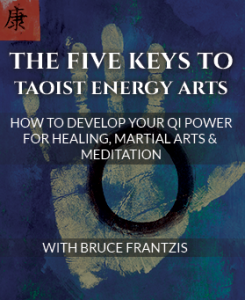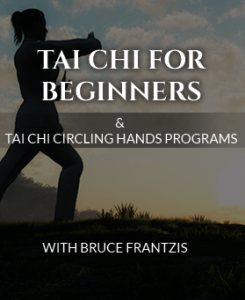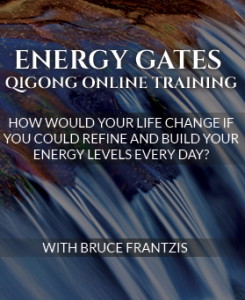Here are five useful tips that I wish I had known before I started tai chi as a beginner:
1. Choose the best tai chi style to achieve your goals.
Each tai chi style has specific benefits associated with it, e.g., Wu style tai chi is the only tai chi style associated with meditation.
2. The physical movements of tai chi comprise about five percent of the art of tai chi.
The other 95 percent is concerned with how you get the chi in your tai chi by integrating the 16 neigong (components of internal power).
3. There are seven basic stages in learning tai chi.
Knowing where you’re at on the map will help you overcome obstacles and personal setbacks to reap the deeper benefits that tai chi has to offer from ongoing practice.
4. Practicing tai chi requires patience.
Chi development progresses from gross to subtle, and the process cannot be rushed.
5. Not all teachers are created equal.
The skill of your teacher and his/her ability to impart their knowledge is invaluable to your personal progress and safety.
—Bruce Frantzis
Learning Tai Chi Fundamentals
In tai chi (taiji), who is the beginner? This is truly a trick question. Even after 20 years of practice, many students genuinely consider themselves beginners, especially after watching a high-level tai chi master at work.
Tai chi’s beginning, intermediate and advanced practices are like a continuum without exact, defining landmarks. Criteria and standards of what constitute beginning, intermediate or advanced methods, vary widely between individual teachers and entire schools of tai chi.
Some teachers have a larger, more complete knowledge of the tradition than others. Consequently, one group’s idea of what constitutes an advanced technique, by another group’s standards may be considered something only marginally more advanced than the basic level.
Within classes, you can expect to learn:
- Sequences of movements
- Basic body alignments
- The 70 percent rule of moderation
- Coordination
- How to protect your joints
During the first year, unless you are exceptionally sensitive, it is unreasonable to expect to feel a lot of chi (qi). Although at its advanced levels tai chi’s primary goal is to grow and balance your chi, in the beginning, approaching your practice only from the perspective of chi is neither necessary nor desirable. Staying grounded in the body tends to keep any self-perceived experiences of energy from being pure fantasy or overly exaggerated.
Tai chi’s physical movements serve as effective sensitivity and awareness exercises that keep the body flexible, reduce stress, and tone and strengthen muscles. In terms of health and longevity, tai chi is a non-impact, physical exercise without any notion of energy.
Thinking about starting a Tai Chi practice, but don’t know where to begin? The Tai Chi for Beginners and Tai Chi Circling Hands® programs are a great place to start. Energy Arts’ Tai Chi for Beginners contains over 40 online lessons on how to do the first 8 moves of the Wu Style tai chi short form. Tai Chi Circling Hands® is a complete energetic exercise and warm-up to any tai chi form or style (Chen, Yang, Wu, and combination forms).
Tai Chi: Body-Energy-Spirit
All Taoist practices are based on the three treasures: body, energy and spirit (jing, chi and shen, respectively, in Chinese). Learning tai chi serves as a body practice, as well as advancement as an energy practice. So, whether or not you have an interest in practicing tai chi for spiritual pursuits, it always starts with the body—making you incredibly healthy down to the cellular level.
Body
The physical body is the container through which your energy and spirit flow. This is the physical approach to health, longevity and optimum performance. Through tai chi, you learn how to exercise the body down to its most subtle aspects. This can best be done if you understand the body’s physical mechanisms and realities, such as anatomical subtleties or how different parts of the body do or don’t work well, or flow together.
Energy
The legendary martial arts abilities of many tai chi masters derive from the development of the many functional kinds of subtle energy. This is where many of the “secrets” are hidden in tai chi and for which some train arduously over decades to achieve and master.
Increasing your life-force energy, which can be achieved from regular tai chi practice, can produce extraordinary healing and provides the gateway to human intuitive or psychic capacities. For people who are overly energetically sensitive or psychically developed, tai chi can help ground and smooth their energy, so they can handle—rather than be overwhelmed by—their natural talents.
Spirit (Mind)
Spirit’s sphere of influence works directly with the mind and the invisible spirit within us. It involves the art and science of meditation, which originally generated the first two levels of body and energy.
Spirit involves active use of the mind. It tells your body and chi when and how to move. Applying your spirit’s energy well is mandatory to get to the root of and fully engage your true personal power, obtain emotional balance and inner peace, and actualize the potential of your mind.
While intent can take you a long way with body and energy, the Heart-Mind is required to fully activate spirit, which is the center of your consciousness. That is the place where thoughts and images come from, before reaching the conscious level.
Working with body, energy and spirit requires beginning, intermediate and advanced techniques. They are learned much the same way as music: basic techniques build on each other until you can seamlessly blend them. The art of tai chi is as complex as the greatest symphony. At its most advanced stages, the body, mind and spiritual components blend into a unified whole that lead you to experiencing the Tao.
Unlike learning music, however, where you progress by learning successively more challenging pieces of music, in tai chi you perform the same series of movements, each time going deeper and learning more.
Learning Tai Chi Is Challenging
Tai chi is challenging to learn. People who do tai chi well make it look easy and effortless. But the truth is, tai chi is not especially easy to learn. An interesting point about learning anything of value is: Things are difficult when you can’t do them and easy when you can. The road to attaining fluidity, smoothness and relaxed movements in your tai chi practice requires much patience and effort, just like any sport or art form.
Tai chi is one of the most sophisticated methods of integrated whole-body movement. It requires, and progressively develops gross and subtle physical coordination.
Tai chi is a workout that can be as strenuous and invigorating as aerobics, even though it can look easy, simple and relaxed. You will likely use muscles that you didn’t know you had. Before you really learn to relax and soften your body, the habitual tension stored in your legs and shoulders may make you tremble and ache.
It is quite normal to feel some emotional unpleasantness, especially as you begin to really notice, often for the first time, what stress is doing to your nervous system, or how unquiet and devoid of inner peace your mind and emotions really are. For everyone, part of learning tai chi is learning to recognize the subtle tensions within your body and mind. This can freak you out, as you may not be able to believe the degree of unconscious tension held by most people. However, if you can overcome it, you will feel truly empowered about your ability to let go.
At first, it may be difficult to practice on your own. It is best not to feel guilty about this; just accept your limitations rather than quitting. Attending a weekly class is the best way to create a regular practice rhythm.
Many students focus on learning movements correctly or doing them perfectly. It is not possible to do tai chi perfectly, so don’t approach learning tai chi with a been-there-done-that mentality.
I remember I once asked my teacher Liu if he had ever done tai chi perfectly, and he said that he had. Later though, he said that he realized he had practiced tai chi even better than the time before! —Bruce Frantzis
Although tai chi is not especially easy to learn, it is not the most difficult thing to do either. Half of China’s 200 million people who successfully learn and practice tai chi daily begin after age 50. If they can learn tai chi, so can you.
Some degree of challenge makes most recreational activities more fun, interesting and alive, whether they are physical (golf, skiing, tai chi), mental (reading good books, doing crossword puzzles), or artistic (playing music, painting). Lack of any challenge causes many activities to become boring, causing people to quit.
Conversely, all worthwhile activities that continue to have both short- and long-term pay-offs usually have continuing challenges.
Building a Sustainable Tai Chi Practice
You don’t have to be an expert to benefit from learning tai chi. Even when done poorly, tai chi fosters vibrant health from deep within your body. As you grow in experience and are able to pay more attention to body alignments and energy mechanics, you’ll find you gain more and more from your practice.
Give yourself time to absorb the big shapes of the movement. The most important thing is to learn the whole sequence together even if you have to fudge some moves. This builds confidence for the long haul. Refining the moves happens with practice, or in the next rounds of learning new information.
If you have specific moves you really like, do them singly outside the sequence of the form. This builds up your confidence and creates the foundational skills needed to eventually overcome the bigger challenges of more difficult moves.
Do not emotionally beat yourself up over moves that you personally find difficult. Just move on and complete the entire sequence as best you can. Don’t get hung up on one or two moves. You will improve with practice.
Ready to begin building your skills? Energy Arts’ Tai Chi for Beginners is designed for a complete beginner, those wanting to learn another form, and for those looking to improve their physical foundation, alignments, and energetics within tai chi.
Also a must for those looking to work on foundational movements, Tai Chi Circling Hands® is a complete energetic exercise and warm-up set to any tai chi form or style. By understanding the three circles that power tai chi, you can improve your form and speed the learning process. More information on Tai Chi for Beginners and Tai Chi Circling Hands® programs can be found here.
Whatever you do, don’t compare your learning speed to others. Tai chi is challenging for everyone to learn, although some will pick it up faster than others. It’s your commitment that matters—not how fast you can play the game.
Above all, be patient with yourself.






0 Comments